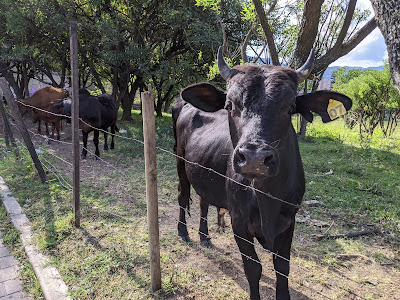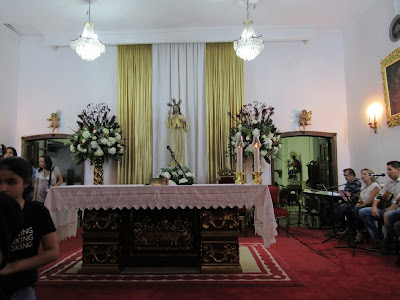So different ... yet it feels like coming home again! We arrived in Medellín, Colombia a week ago ready to start another four month adventure.
Our apartment for the first two months in located in a different barrio (neighborhood) than last year. Instead of being in the ''tourist'' part of Medellín, we opted for a more ''local'' barrio in Envigado, the city directly south of Medellín. Happily, we are just a 15 walk away from the Metro that quickly brings us to the many sights of the big city. But, we have also found that most everything that we need is right here. We just need to walk down our street to find freshly made buñuelos, colorful fruit, meat, groceries, and a couple of local cafés that appear to provide food and drink as well as lively music well into the night.
We are thrilled to be back and happy that our fruit dish is once again overflowing with sweet delicacies! We are looking forward to hosting a couple of our friends who bravely took us up on our offer to come explore ''The City of Eternal Spring''. Because a Colombian vacation is definitely different than traveling in the United States, I have decided to highlight some of the unique differences. This will hopefully serve as an orientation for our visitors ... and maybe convince others to come explore this beautiful country.
Bienvenidos a Nuestra Casa!
Regarding Money
No need to bring a lot of US dollars ... just enough to buy food and drinks during the US leg of your air travel. All you need is a cash card. When you arrive at the Medellín airport, there are ATMs that will give you Colombian pesos (cop) for a minimal fee if you need it for the taxi ride into Medellín. Most times your hosts will be meeting you there. The airport ATMs charged us 18,000 cop ($6) service fee to get out 400,000 cop ($122). We have found that the ATMs associated with Daviviendo Bank in Medellín don't charge any service fee. Speaking of money, you will initially think that the prices are very high, but actually, the cost of most items is about 1/3 the cost of them in the US. For example:
- 2 or 3 Buñuelos cost 1,000 cop = $0.33
- A large glass of limonada de coco (Doug's fav) costs 6,000 cop = $2
- A cup of wonderful Colombian café costs 3,000 cop = $1
- A large freshly picked mango costs 1,200 cop = $.40
So, as you can see ... take the number before the comma and divide by 3 to (sort of) get the price in US dollars.
Food Basics
You will not starve! There is food available everywhere ... from street vendors, to small corner groceries, to cafés and restaurants. A trip to the grocery store is an adventure in itself. Be prepared to find many different types of products then are found in the typical US grocery. There are huge amounts of arepas, cheese, beans, rice, eggs, meats, cooking oil, fruits and vegetables to be found, but not much of the already prepared foods or sweet treats that are popular in the US. Since the cost of some of the ingredients that I am used to cooking with seem a bit high, I am trying to become more of a Colombian cook ... arepas and eggs for breakfast, fresh fruit smoothies for lunch, and going out to eat a least once a day because ...
Who Wants To Cook?
Restaurants are plentiful, delicious, and very reasonably priced. Most of local cafés have a ''Menu del Día'' special (pictured above) during the lunch hour. For between 10,000 and 15,000 cop ($3.50 and $5), you can get a full meal of soup, meat (or veggie substitute), rice, beans, salad, arepa and dessert. An elegant Italian dinner at a local restaurant cost us about $30 for two juices, bread, salad, entrees, coffee, dessert, taxes and tip.
Our Apartment
Welcome home! We are very pleased with the AirBnB apartment that we found at the last moment when the owner of our first choice cancelled two weeks before we were to arrive. That is one of the risks with using the AirBnB app, but for the most part, we have been very pleased with the accommodations that we have found through the app.This apartment has everything that we need including a fully equipped kitchen, three bedrooms, two bathrooms, and washing machine. The kitchen cooking utensils seem to be geared more towards Colombian cooking, so I may have to use the big pots for ajiaco soup, the arepa pan for the Colombian breakfast staple, and the blender for fresh fruit smoothies. With perfect weather all year long, no heating or air conditioning is needed. Also, you will find very few if any bugs around here, so no window screens are necessary either. Open air perfection!
Getting Around
Bring good walking shoes! One of the reasons we love Medellín is that it is so easy to get around without a car. With two huge shopping malls 15 minutes away, we can walk to get just about anything that we should need. Located by the malls are Metro stations. For about $.75, you can hop on the Metro and get just about anywhere you want to go in town. We have the Civica cards which allows us (and our special friends) to avoid long ticket lines when getting on the Metro. Buses and taxis are also plentiful and appear to be easy to use although we haven't used them much in the past. Last year, we loved using Uber to get around, but the local government recently shut them down, so I imagine that we will get to figure out the taxi service around here at some point.
Safety
Get ready to see and experience just about anything on your walks. From gorgeous flowers and shrubbery growing along the road to curious cows greeting us as we pass by ... there is no such thing as a ''dull'' walk! But a word of caution: Always watch out for the traffic. Fast moving cars, buses, motorcycles, and bicycles can make crossing an intersection a less than pleasant experience. They don't seem to like to use their ''blinker juice'' very much around here. What we learned as kids is very important here ... always look twice before crossing, even if you have the green ''walk'' sign. Most streets have sidewalks, but they can be of varying width and condition. ''Watch out for potholes'' applies to pedestrians as well as drivers since the sidewalks are full of all types of hazards that can trip you up.Also, while our apartment seems to be in a very safe barrio, be sure that you don't ''Dar Papaya'', This means that you should not have cell phones, wallets, purses, or anything valuable out in the open when walking in busy public spaces. Many locals use backpacks to secure their items. And speaking about safety, it is a good idea to ''blend in'' with the locals which in Medellín means wearing long pants, a casual shirt, and tennis shoes when out in the public.
 |
| However, traditional Colombian hats are optional ;-) |
Rules of La Casa
There are a few things that we have found a little ''different'' from the US, so here are just a few good rules to live by when visiting Colombia.- Like other foreign countries (and so unlike the US ... unless you live in a small RV), NO toilet paper in the toilet.
- The water is safe to drink right out of the faucet ... at least in Medellín. Not so in other Colombian cities.
- It is good to know at least a little Spanish, as English is not spoken much around here. Your host, Doug is getting pretty proficient in understanding and communicating in Spanish, while I am better at figuring out what they are saying by studying their ''body language''.
- The apartments walls don't have much insulation and the windows are always open, so noise travels easily ... especially in the evening. And Colombians love to socialize in the evenings and late into the night. We try to be quiet after 10, but we always seem to fall asleep to good music and lively conversations taking place in the streets below.
- Spanish lessons are available in our apartment compliments of the Disney channel. I am working up to the ''child proficiency'' level, and Disney's cartoons provide some of my favorite ''lessons''.
Enjoy Life Like a Paisa!
Visitors to Medellín are tempted to try to ''do it all'' during their short time here. But take a lesson from a Paisa (the term for the people of Medellín) ... La Vida Es Tranquila! Be prepared to enjoy a tranquil experience on ''Colombian time''. No need to hurry. Take time enjoy a cool juice or fresh empanada with friends. Paisas are friendly and always willing to help. Get ready to hear and respond to ''buenos días'' (before 12 noon), ''buenas tardes'' (12 noon to about 9 pm) and ''Buenas noches'' (at bedtime). While most people just speak Spanish, I have found many Paisas have a desire to learn English. At language exchanges (of which we will drag you to at least once), you will be the most popular person there. Yah, you betcha ... Paisa English learners love to hear the clear Minnesota accent!So kick back ... forget about snow and cold ... sip a cold jugo or cerveza while hanging out in the city square ... and enjoy a tranquilo way of life!
Bienvenidos a nuestra casa!























































































